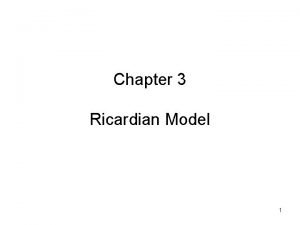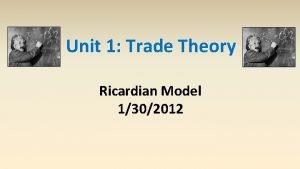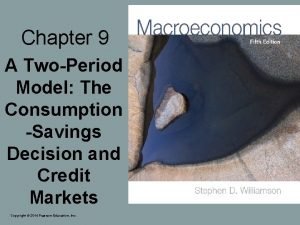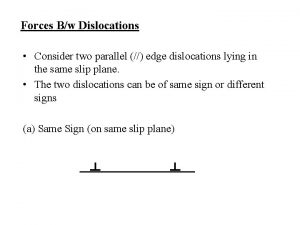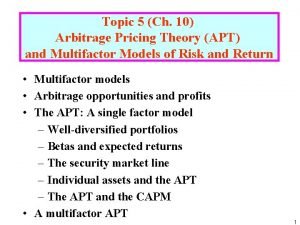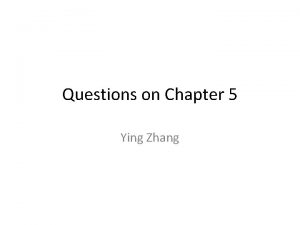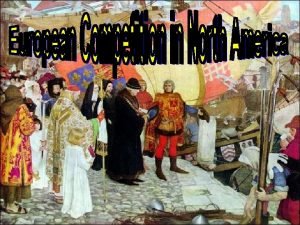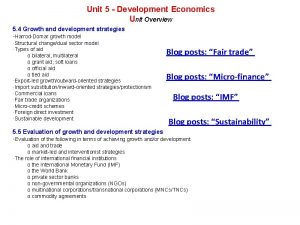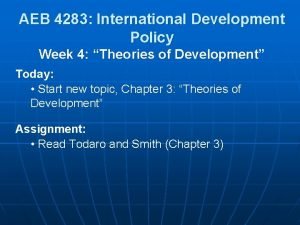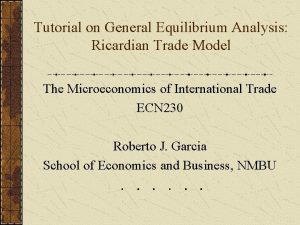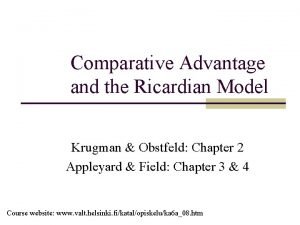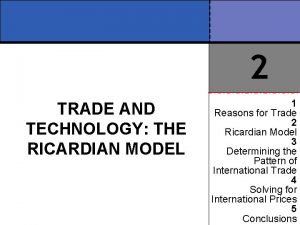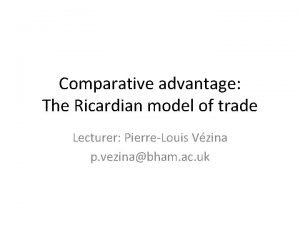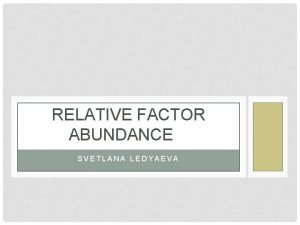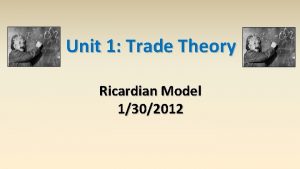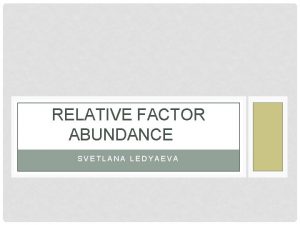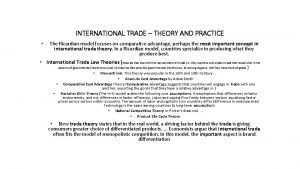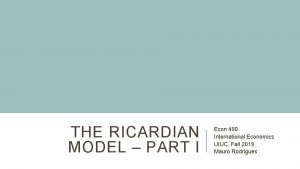1 Consider the Ricardian model with two countries












- Slides: 12

1. Consider the Ricardian model with two countries (Home and Foreign), two goods (Steel and Beans) and one factor (labor). Suppose that each worker in Home can produce five tons of steel or three tons of Beans. Suppose that each worker in Foreign can produce one ton of steel or two ton of Beans. There is one worker in Home and four workers in Foreign. (6 p) a. Derive and graph the production possibilities frontier (PPF) for Home. Use a diagram where you put Beans on the x-axis and Steel on the y-axis. (1 p) b. What is the no-trade relative price of Beans in Home? (1 p) c. Derive and graph the production possibilities frontier (PPF) for Foreign. Use a diagram where you put Beans on the x-axis and Steel on the y-axis. (1 p) d. What is the no trade relative price of Beans in Foreign? (1 p) e. Which country has a comparative advantage in the production of Beans? Explain why. (1 p) f. Which country has a comparative advantage in the production of Steel? Explain why(1 p) 2. Continue with the model in Question 6. Suppose that there is now trade between Home and Foreign. Suppose that the world relative price of Beans in the trade equilibrium is (P Bean/PSteel)Int =1. (4 p) a. In which good will Home specialize? (1 p) b. In which good will Foreign specialize? (1 p) c. Use the labor market equilibrium to give a formal proof to your answer in Question 7 a. (2 p)

6. a. Derive and graph the production possibilities frontier (PPF) for Home. Use a diagram where you put Beans on the x-axis and Steel on the y-axis. (1 p) 6. b. What is the no-trade relative price of Beans in Home? (1 p) 12 11 10 9 8 7 6 5 Home’s PPF: Slope = - 5/3 = PBean/PSteel 4 3 2 1 1 2 3 4 5 6 7 8 9 10 11 12

6. c. Derive and graph the production possibilities frontier (PPF) for Foreign. Use a diagram where you put Beans on the x-axis and Steel on the y-axis. (1 p) 6. d. What is the no trade relative price of Beans in Foreign? (1 p) 12 11 10 9 8 7 6 5 Foreign’s PPF: Slope = - 4/8 = -1/2 = P*Bean/P*Steel 4 3 2 1 1 2 3 4 5 6 7 8 9 10 11 12

6. e. Which country has a comparative advantage in the production of Beans? Explain why. (1 p) 6. f. Which country has a comparative advantage in the production of Steel? Explain why(1 p) Note: P*Bean/P*Steel = 1/2 < 5/3 = PBean/PSteel => Foregn CA in Beans P*Steel/P*Beans = 2 > 3/5 = PSteel/PBeans => Home CA in Steel

7. a. In which good will Home specialize? (1 p) Steel 12 11 10 9 8 World price line: Slope = - 1 7 6 Export: 2 tons of steel 5 B C 4 3 Trade triangle Home’s PPF: Slope = - 5/3 A 2 1 1 2 3 4 5 6 7 Imports: 2 Tons of Beans 8 9 10 11 12

7. b. In which good will Foreign specialize? (1 p) 12 Beans 11 10 World price line: Slope = - 1 9 8 7 6 Foreign’s PPF: Slope = - 4/8 = -1/2 = P*Bean/P*Steel 5 4 3 Export: 2 tons of Beans C* 2 1 A* 1 2 3 4 5 6 7 8 B* 9 10 11 12 Imports: 2 Tons of Beans

7. c. Use the labor market equilibrium to give a formal proof to your answer in Question 7 a. (2 p)

3. Shorter questions (5 p): a. ) You are advisor for the EU. You are asked if export subsidies can increase total welfare in the EU. You go through the range of industries that may be subject to export subsidies and find that some industries are characterized by perfect competition and others by imperfect competition. What should you answer in each type of industry? ANSWER: Perfect competition => no subsidies (large country case even worse since world market price is reduced); IMPERFECT COMPETITION=> case for subsidies (remember Boing-Airbus) can be made b. ) Why is the Specific-factors model referred to as a “short-run model. ANSWER: In the short run, as in the spec factors model, some factors are stuck in a sector (whereas other factors are mobile). In the long run all factors are mobile between sectors) c. ) In 1989 Canada signed a free-trade agreement with the US. Daniel Trefler found in study productivity rising as much as 15% in Canadian industries most affected by tariff cuts. Use monopolistic competition model to explain such a productivity increase from trade. ANSWER: Trade will increase the number of firms. However, total number of firm will be less than the total number of firm in the US and Canada under autarchy, thus there are exits of some firms and the firms who survive are larger. With more firms competing under trade, consumer prices decrease and average cost fall (gain for consumers and an efficiency gain). (This follows from P=AC) d. ) Consider the market for cars. Assume that VOLVO is the only Swedish car producer in Sweden. VOLVO is small in the world market. The Swedish government wants to protect VOLVO in the Swedish home market from foreign import competition, but is concerned for the effect on Swedish consumers. The government chooses between an import tariff and a quota on imports. You are an advisor of the government and you are instructed to maximize the share holders profit in VOLVO. Should you use a tariff or quota? Explain briefly why. ANSWER: You should choose the quota. This will maintain monopoly power: VOLVO acts as a monopolist in Sweden on the residual demand creates after foerign firm export the quota. While the tariff raises the price of cars, it does not maintain market power for VOLVO in the Swedish market. e. ) Consider the Heckscher-Ohlin model in which there are two goods (Steel and Textiles), two factors (capital and labor) and two countries (Home and Foreign). Steel is capital-intensive in production; T is labor-intensive in production. Home is capital-abundant; Foreign is labor abundant. Suppose that Home and Foreign trade freely with each other. Which good will Home import and which good will Home export under free trade. ANSWER: Home imports Textiles and exports Steel.

Question 4: a = 20 x 30 =$600 Figure 1: The market for wheat in Home price, $ Answer b. ) Exports=60 ton with subsidy/tariff (0. 5 p) D b = (20 x 20)/2 = $200 a c = 20 x 20/2 +20 x 20+ 20 x 20/2 =$800 S 70 d = 20 x 20/2=$200 World market price +export subsidy: 60 t=s a 50 c b 40 d World market price: 30 (i) Change in consumer surplus = -(a+b)= - $800 (ii) Change in producer surplus = a+b+c= $1600 20 10 0 Answer c. ) (2 p) 0 10 20 30 40 50 60 70 80 90 Answer a. ) Exports=20 ton with free trade (0, 5 p) 100 Q (tons) (iii) Change in government revenue = -(b+c+d)= -$1800 (iv) Change in overall welfare = -(b+d) = - $400 Answer d. ) (2 p) Loss in welfare due to: • Consumption loss (due to too small consumption) = b • Production loss (due to too large production) =d

Question 7: Explain • a. ) MFN: cannot set discriminating tariffs between WTO members (2 p) • b. ) Safeguard: extreaordinary losses for domestic producers from trade allow temporary tariffs? (2 p)

Question 8 b = (20 x 20)/2 = $200 Figure 2: The market for sugar in Home price, $ d = (20 x 20)/2=$200 Answer c. ) (2 p) S D Answer a. ) No trade price of sugar = 50 $/ton (1 p) 70 60 Change in overall welfare from trade = (b+d) = 200 +200 =400 50 40 b 30 d world market price: a 20 10 0 0 10 20 30 40 Answer b. ) Imports=40 ton at old world market price (1 p) 50 60 70 80 90 100 Q (tons) c. ) cont Intuition (not needed): trade leads to a production gain b (arising since production costs at home are larger than the world market price). Production is reduced with 20 tons. These 20 tons are replaced with imports at a lower price than the production cost (MC) Trade leads to a consumption gain d (ioncreased consumer surplus due to the higher consumption with 20 tons): (b+d)>0

a = 10 x 30 + (10 x 10)/2=$350 Question 8, d. ) b = (10 x 10)/2 = $50 Figure 2: The market for sugar in Home c = 10 x 20 =$200 d = (10 x 10)/2=$50 Home price, $ S D No trade price of sugar = 50 $/ton 70 60 50 t World market price + tariff 40 a 30 b c d Old world market price: a 20 10 0 Answer d. ) (i) Change in consumer surplus = -(a+b+c+d)= - $650 (ii) Change in producer surplus = a= $350 (iii) Change in government revenue = c= $200 (iv) Change in overall welfare =-(b+d) = - (50 + 50) =-100 0 10 20 30 40 Imports=40 ton at old world market price 50 60 70 80 90 100 Q (tons) Intuition (needed): The tariff leads to a production loss b (arising since production costs are larger than the world market price) and the consumption loss d (lost consumer surplus due to the higher home price): -(b+d)<0
 Ricardian model relative price
Ricardian model relative price Ricardian model ppf
Ricardian model ppf Ricardian equivalence
Ricardian equivalence Ricardian rent definition
Ricardian rent definition Consider two edge dislocations of opposite sign
Consider two edge dislocations of opposite sign Arbitrage pricing theory
Arbitrage pricing theory Consider a case of a two-component standby system
Consider a case of a two-component standby system Show that the maximum efficiency of pure aloha is 1/(2e).
Show that the maximum efficiency of pure aloha is 1/(2e). What flag did henry hudson sail for
What flag did henry hudson sail for Five stages of economic growth
Five stages of economic growth Harrod-domar model
Harrod-domar model Hình ảnh bộ gõ cơ thể búng tay
Hình ảnh bộ gõ cơ thể búng tay
